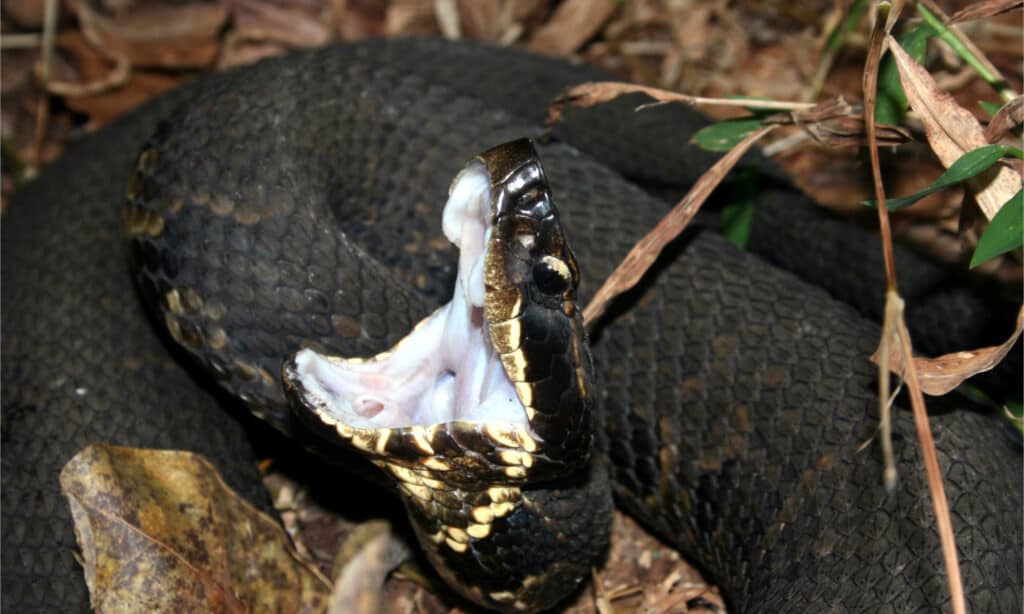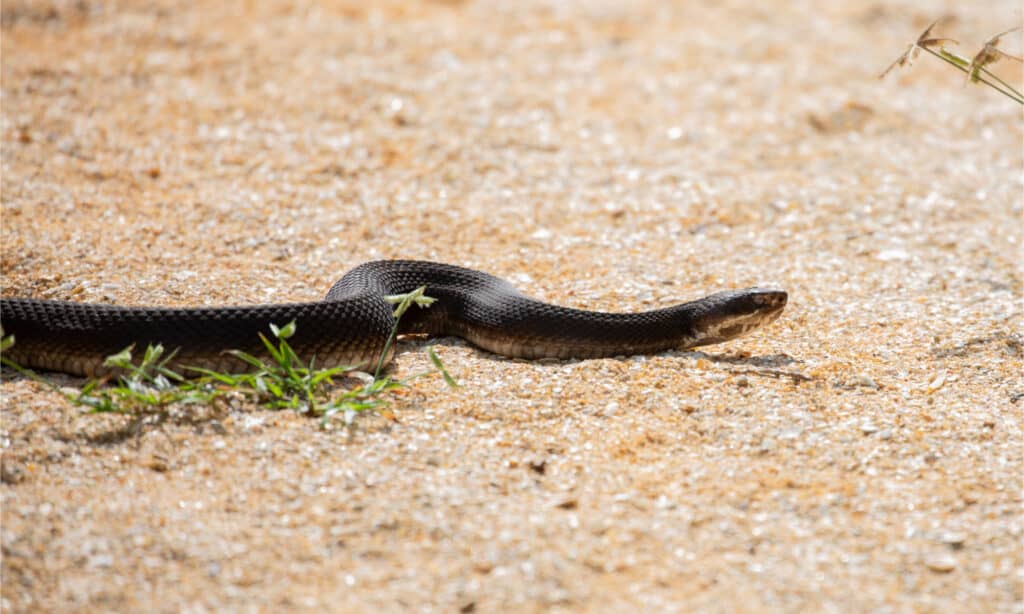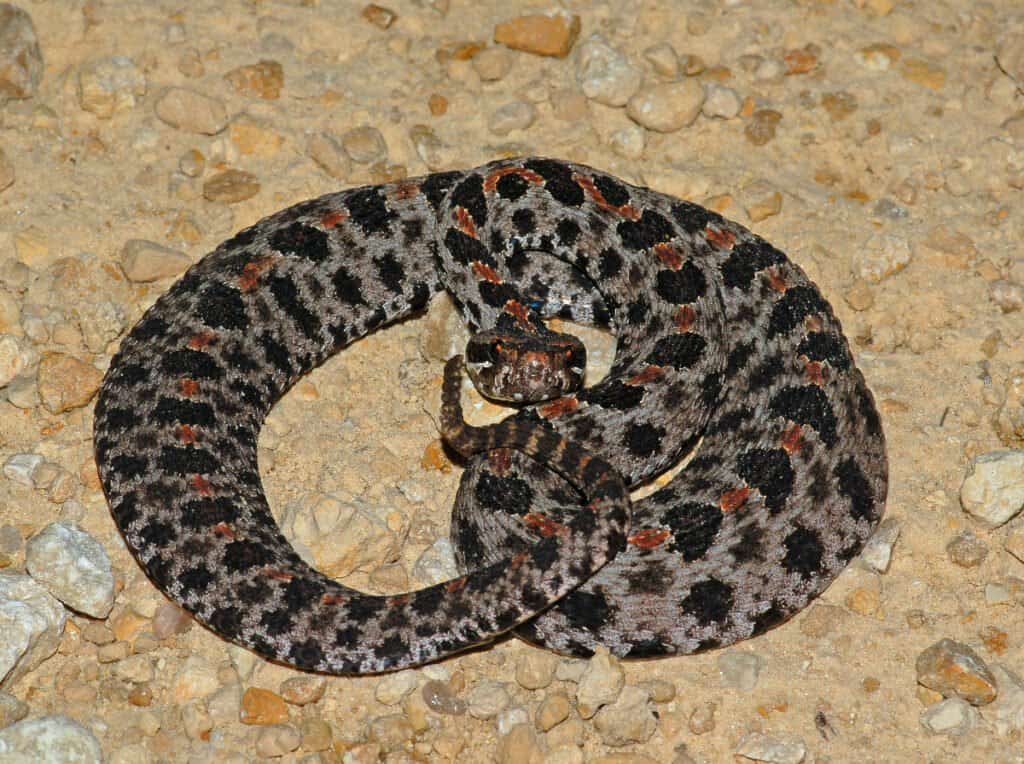Tennessee is a stunning state in the southeastern region of the US. It is completely landlocked and is bordered by eight other states. Tennessee has many different habitats – including mountains, rivers, swamps, plateaus, and plains. Although there are many different animals in the state, snakes are particularly common. There are 32 species of snakes in the state, of which four are venomous – including the well-known cottonmouths. But where do they live, and just how dangerous are they? Join us as we discover the cottonmouths in Tennessee!
Identifying Cottonmouths

Cottonmouths are venomous snakes with dark-colored bodies.
©Psychotic Nature/Shutterstock.com
Cottonmouth snakes are pit vipers which are often called water moccasins due to their aquatic nature. There are currently two species of cottonmouths, although there was formerly only one species. The Florida cottonmouth (Agkistrodon contati) is native only to Florida and parts of Georgia, while the northern cottonmouth (Agkistrodon piscivorus) is found across much of the remaining southeastern area of the United States. The northern cottonmouth is the species that is native to Tennessee, but from now on in this article, we’ll simply refer to them as cottonmouths.
Cottonmouths are large snakes and reach 30 to 43 inches long. They have dark-colored bodies, which are typically dark brown with black crossband markings. However, sometimes these snakes can have a ground color that is almost black which therefore renders their markings almost indistinguishable. As juveniles, cottonmouths have a yellow tail tip, a tan body, and reddish crossbands.
However, the reason that cottonmouths are called that name is because of their mouth. All cottonmouth snakes have a white-colored lining inside their mouth, which is described as being like cotton. Although we really don’t recommend it, this is most often seen when the snake is trying to defend itself by opening its mouth to show off this lining.
Where do Cottonmouths Live in Tennessee?

You can find cottonmouths in the western third of Tennessee.
©Linda Burek/Shutterstock.com
We’ve already mentioned that cottonmouths have an aquatic nature, and although they are classed as being semi-aquatic, they rarely stray far from water. In fact, they always live near a permanent source of water – whether that be swamps, rivers, streams, or even ditches.
However, in Tennessee, cottonmouths are restricted to only the western third of the state. Although they are widespread in this area of the state, they are particularly common in Reelfoot Lake and the surrounding swamps.
Cottonmouth Venom
Cottonmouth snakes contain a large amount of highly potent venom, and in most cases, a single bite from one of these snakes can inject around 125mg of venom. However, the highest estimations put this figure at 237mg. For reference, anything between 100 and 150mg of cottonmouth venom can be lethal to humans. However, not all venom is created equal.
Although it might seem surprising, not all venomous snakes contain the same type of venom. There are four types of venom, and they work in different ways. This is why they have different danger levels and fatality rates. The different types of venom are cytotoxic, neurotoxic, hemotoxic, and proteolytic.
Cottonmouths produce cytotoxic venom, which is not necessarily as fatal as other types of venom but can still be incredibly dangerous. This is because cytotoxic venom destroys the tissue when it enters the body. In some cases, it can cause the tissue to die (necrosis), resulting in severe scarring and even loss of limb.
How Dangerous are Cottonmouths in Tennessee?
Although snakes are one of the most widely feared animals in the world, statistically, they don’t actually kill many people. Of approximately 7,000 to 8,000 snake bites in the United States every year, there is an average of five deaths. If we break this down further to just cottonmouths, then they are responsible for only 1% of these. However, if we only take into account snake bites in the southeastern region – the cottonmouths range – then this figure does rise to 7.3%.
There are no records documenting snake bites in Tennessee, so it is difficult to reliably say how dangerous cottonmouths are in the state. However, the lack of information regarding any bites or deaths suggests that bites from cottonmouths in Tennessee are fairly rare. Instead, the title of the most dangerous snake in Tennessee goes to the timber rattlesnake.
What Happens if You See a Cottonmouth?
Although cottonmouths can be dangerous, studies suggest that around 50% of them will flee when they are disturbed. Unfortunately, the majority of snake bites occur when the snake is accidentally stood on – and when it comes to cottonmouths, this can happen in the water too.
If you do see a cottonmouth snake, the main thing is to back away slowly so that you don’t further provoke it. This also allows the snake the opportunity to move away, and with cottonmouths, the first place they are going to want to head is back into the water.
If you are unfortunate enough to be bitten by a cottonmouth snake, then the first thing you should do is to get yourself medical help immediately (although this goes for any snake bite, not just cottonmouths). Even if you don’t think the bite looks or feels that serious, a snake bite can get much worse in a matter of hours. When it comes to a cottonmouth bite, then you are likely going to know about it straight away as the main symptoms are swelling of the affected limb and intense pain in the surrounding area. Thankfully, there is anti-venom available for these bites, but again, the speed at which you get help makes all the difference to how serious the bite is.
Other Venomous Snakes in Tennessee
The cottonmouth isn’t the only dangerous snake in Tennessee, as there are three other venomous snakes in the state. Therefore, we thought we’d give you a quick overview of these and tell you where they live too.
Copperhead

There are two copperhead subspecies in Tennessee.
©Creeping Things/Shutterstock.com
The copperhead is one of the more dangerous snakes in Tennessee. These snakes range between 20 and 37 inches long and have a pinkish-tan ground base color with dark brown crossband markings. There are two subspecies in Tennessee. The southern copperhead lives in the western region of the state, while the northern copperhead occurs across the rest. They mainly live in forested regions and on rocky hillsides.
Pygmy Rattlesnake

Pygmy rattlesnakes live mainly on floodplains.
©Gerald A. DeBoer/Shutterstock.com
The pygmy rattlesnake is the smallest and least dangerous of Tennessee’s venomous snakes. Pygmy rattlesnakes are only 15 to 25 inches long and are grey with black or dark brown blotches and a red dorsal stripe. These snakes live mainly on floodplains and near wetlands in Tennessee along the western highland rim between Stewart county and the southern border. As pygmy rattlesnakes are so small, they do not contain enough venom to be dangerous to healthy adults.
Timber Rattlesnake

The most dangerous snake in Tennessee is the timber rattlesnake.
©Frode Jacobsen/Shutterstock.com
The timber rattlesnake is generally classed as the most dangerous snake in Tennessee – and the largest. These snakes are 36 to 60 inches long and have dark brown bodies with black crossbands. They occur statewide but mainly live on rocky hillsides.
Up Next:
- Copperheads in Tennessee: Where They Live and How Often They Bite
- 32 Snakes in Tennessee
- Discover the Most Dangerous Animals in Tennessee
The photo featured at the top of this post is © Ad Konings/Shutterstock.com
Discover the "Monster" Snake 5X Bigger than an Anaconda
Every day A-Z Animals sends out some of the most incredible facts in the world from our free newsletter. Want to discover the 10 most beautiful snakes in the world, a "snake island" where you're never more than 3 feet from danger, or a "monster" snake 5X larger than an anaconda? Then sign up right now and you'll start receiving our daily newsletter absolutely free.
Sources
- National Library of Medicine, Available here: https://www.ncbi.nlm.nih.gov/books/NBK546645/
- Center for Disease Control and Prevention, Available here: https://www.cdc.gov/niosh/topics/snakes/default.html#:~:text=Each%20year%2C%20an%20estimated%207%2C000,than%20to%20die%20from%20them.
- Live Science, Available here: https://www.livescience.com/43597-facts-about-water-moccasin-cottonmouth-snakes.html#:~:text=%22Like%20all%20pit%20vipers%2C%20%5B,which%20is%20often%20potential%20prey.
- Tennessee Wildlife Resources Agency, Available here: https://www.tn.gov/twra/wildlife/reptiles/snakes/cottonmouth.html#:~:text=These%20venomous%20snakes%2C%20also%20commonly,is%20recognized%20in%20the%20state.
Thank you for reading! Have some feedback for us? Contact the AZ Animals editorial team.






